|
home | what's new | other sites | contact | about |
||
|
Word Gems exploring self-realization, sacred personhood, and full humanity
Emily Dickinson Hope is the thing with feathers
Emily Dickinson (1830-1886)
Hope is the thing with feathers And sweetest in the gale is heard; I 've heard it in the chillest land,
from https://www.litcharts.com/poetry/emily-dickinson/hope-is-the-thing-with-feathers "Hope is the thing with feathers" (written around 1861) is a popular poem by the American poet Emily Dickinson. In the poem, "Hope" is metaphorically transformed into a strong-willed bird that lives within the human soul—and sings its song no matter what. Essentially, the poem seeks to remind readers of the power of hope and how little it requires of people. The speaker makes it clear that hope has been helpful in times of difficulty and has never asked for anything in return. "Hope is the Thing with Feathers" is one of a number of poems by Dickinson that breathes new life into an abstract concept by using surprising imagery and figurative language. The speaker defines "Hope" as a feathered creature that dwells inside the human spirit. This feathery thing sings a wordless tune, not stopping under any circumstances. Its tune sounds best when heard in fierce winds. Only an incredibly severe storm could stop this bird from singing. The "Hope" bird has made many people feel warm. The speaker has heard the bird's singing in the coldest places, and on the weirdest seas. But in the speaker's experiences, even the most extreme ones, the bird has never asked for anything in return. “Hope is the thing with feathers” is a kind of hymn of praise, written to honor the human capacity for hope. Using extended metaphor, the poem portrays hope as a bird that lives within the human soul; this bird sings come rain or shine, gale or storm, good times or bad. The poem argues that hope is miraculous and almost impossible to defeat. Furthermore, hope never asks for anything in return—it costs nothing for people to maintain hope. By extension, then, “Hope is the thing with feathers” implores its readers to make good use of hope—and to see it as an essential, deeply valuable part of themselves. The poem begins by establishing its key metaphor—that hope is a bird. It then tells the reader more about this bird, adding detail, before showing it in different situations. The poem concludes by stating that, despite all it does, hope never asks for anything from the speaker. Overall, then, the poem turns hope into a vivid imagined character in order to show how important it is, both to individuals and to humanity as a whole. The poem initially defines hope as “the thing with feathers.” Though it’s obvious that this is a bird (as confirmed in line 7), the unusualness of this first description shows that the poem wants the reader to look afresh at hope—to see hope with clear eyes and not take it for granted. Starting with “hope is a bird” would have the same literal meaning but would feel much less surprising, and the surprise element helps establish the poem’s purpose of redefining hope. This "Hope" bird “perches” in the soul, showing that the soul itself is hope’s home. Hope is thus directly linked with the human spirit, where it sings without ever stopping. This perseverance, then, is a representation of humanity’s infinite capacity for hope. Even in the depths of despair, the poem seems to say, people can still have hope—and this hope will sustain them. Indeed, the bird sings “sweetest” in the storm. In other words, hope shows its importance in times of adversity and seems to guide people through that adversity. This point could apply to humanity’s challenges in a general sense, or it could relate to more personal experiences like individual grief and loss. In either case, hope gives people the strength to carry on, and it’s at its most useful when circumstances are at their worst. Of course, there might be times when people do seem to lose their strength—but, the poem argues, hope still plays an important role in these situations. The poem demonstrates this by gesturing towards the sheer number of people (“so many”) who have been sustained by hope, saying that it would have to be a truly “sore” “storm” that could diminish the strength of “the little Bird.” Hope, it seems, can keep people “warm” even in the worst situations. And though hope is so essential to human life, the beauty of it—according to the poem—is that it requires practically nothing of people. Hope costs nothing, not a “crumb”—yet it can literally and figuratively keep people alive. With hope, people can make it through the hardest of times—they just have to listen to “the little Bird” singing its tune. Overall, then, “Hope is the thing with feathers” implores its readers to value their capacity for hope—and to recognize that it’s never really gone. Without becoming overly specific, the poem argues that hope can be especially helpful in the most extreme situations and that people should therefore rely on it as a precious resource.
|
||
|
|
